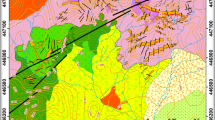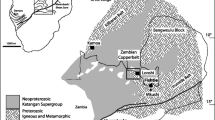Abstract
Copper and subordinate molybdenum mineralization at Malanjkhand occurs within a fracture-controlled quartz-reef enclosed in a pink granitoid body surrounded by grey-granitoids constituting the regional matrix. Sulfide-bearing stringers, pegmatites with only quartz + microcline and sulfide disseminations, all within the pink-granitoid, represent other minor modes of occurrences. Despite this diversity in mode of occurrence, the mineralogy of ores is quite consistent and conform to a common paragenetic sequence comprising an early `ferrous' stage of precipitation of magnetite (I) and pyrite (I) and, the main-stage chalcopyrite mineralization with minor sphalerite, pyrite (II), magnetite (II), molybdenite and hematite. Both stages witnessed continuous precipitation of quartz ± microcline ± (chlorite, biotite and epidote). The enclosing pink-granitoid and the regional grey-granitoids display alteration features such as saussuritization of plagioclase, breakdown of hornblende and chloritization of biotite on a regional scale, indicating interaction with a pervasive fluid. Quartz and microcline precipitation mostly restricted within the pink granitoid, postdates this alteration. Four types of primary inclusions were encountered in quartz from ore samples: (1) type-I – aqueous-biphase(L + V) inclusions, the commonest variety in all ore types; (2) type-II – aqueous-carbonic(Laq + Lcarb ± Vcarb); (3) type-III – pure-carbonic(Lcarb ± Vcarb) – type-II and III being restricted to stringer and pegmatitic ores, and (4) rare polyphase (Laq + Vaq + calcite/gypsum) inclusions. Quartz in granitoids contain primary type-I inclusions only. Type-I inclusions from ore samples furnish a temperature range (after a rough pressure correction to the T H -maxima of 140–180 °C) of 150–275 °C and a moderately low salinity of 4–12 wt.% NaCl equivalent. This is inferred to represent the signature of the major component (F2) of the ore fluid. A few type-I inclusions of higher T M (up to 380 °C) and low salinity and density represent the other (F1) identifiable component of the ore fluid present in low proportion. The T H -maxima and the total range in salinity of type-I inclusions in quartz from granitoids are strikingly similar to those from the ore samples. Composition of syn-ore chlorites furnished a temperature range of 185–327 °C, which conforms to the fluid inclusion microthermometric data. Pressure estimates using standard fluid inclusion geobarometric methods, vary from 550 to 1790 bar in the stringer ores. Observed temperature-salinity/density relationships are best explained by a two-stage evolution model of the ore fluid: the first stage witnessed mixing of the two components, F1 and F2 in unequal proportion, bringing about mineralization. The second stage of evolution was marked by the separation of a carbonic component on continued sulfide precipitation and attendant increase in salinity of the fluid. The F1 component emerged as a distinct, heated and (CO2 + S)-charged entity due to steam-heating and contamination of the early-ingressed F2 fluid at the fracture zone. The pervasive fluid phase in the surrounding granitoids contributed the F2 component.
Similar content being viewed by others
Author information
Authors and Affiliations
Additional information
Received: (10 August 1994), 15 August 1995 / Accepted: 12 January 1996
Rights and permissions
About this article
Cite this article
Panigrahi, M., Mookherjee, A. The Malanjkhand copper ( + molybdenum) deposit, India: mineralization from a low-temperature ore-fluid of granitoid affiliation. Mineral. Deposita 32, 133–148 (1997). https://doi.org/10.1007/s001260050080
Issue Date:
DOI: https://doi.org/10.1007/s001260050080




